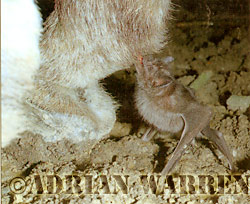Desmodus feeding on a donkey's ankle
Before actually biting, the vampire often spends several minutes at its chosen site, sniffing and licking. The bat's saliva contains a mild anaesthetic so that the bite might be relatively painless. The long fangs, the canine teeth so characteristic of the fictional Dracula, apparently enable the bat to shave some of the hairs at the chosen spot. Then it bites, using its razor-sharp incisor teeth to make a shallow scoop in the flesh and discarding the small piece of skin it has removed. The donkey appeared to be aware of the bite but not particularly worried. It shifted its hoof as if shrugging off a persistent insect and the bat hopped backwards out of the way before moving in again to lap the blood that was gently flowing from the wound. Our lights, which were now on continuously, enabled the donkey, on occasion, to catch sight of the vampires as they scuttled in; at that he would shift nervously but most of the time he stood quietly. Once the bat was feeding, Martin was able to creep slowly in with the camera until finally he was only inches away from the bat using close-up attachments on the lens. The feeding would continue for as long as 40 minutes, the blood kept flowing by an anti-coagulant in the bat's saliva. In fact for quite a while after the bat staggered off with its belly full, the blood continued to flow; for such a tiny wound the loss of blood was large and for a smaller animal might have serious consequences to its health, but an animal as large as a donkey would have to be bitten a great many times to suffer as a result of blood loss. More serious is the threat of rabies, the virus of which is carried and transmitted through the bat's saliva. The work of the Trinidad bat group is to keep the vampire population down to a manageable level, destroying troublesome roosts and sampling others continuously to test for rabies. The statistics suggest that today, only one in two hundred vampires is likely to be a reservoir for the disease. The thought certainly crossed our minds that perhaps we should be chasing the bats off the donkey rather than settling to film the spectacle in all its grisly detail, but the donkey survived, and the owner constructed a vampire proof stall. It is difficult to admire any animal that feeds on another's blood, but perhaps that is not very logical. After all, we have considerable regard for countless other cruel predators like lions.

